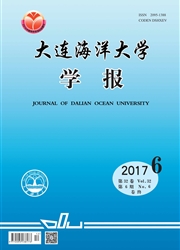

 中文摘要:
中文摘要:
在16、20、24℃3个温度条件下,以三氧化二铬(Cr2O3)作为标记物,测定了双齿围沙蚕Perinerein aibuhitensis对牙鲆配合饲料的表观消化率(AD)。沙蚕按湿重分为3组:S组(0.50g±0.19g)、M组(1.00g±0.22g)和L组(2.00g±0.50g)。结果表明:1)摄食混合Cr2O3饲料的沙蚕与摄食正常饲料的沙蚕体内Cr的残留量差异不显著(P=0.686,F=0.189)。2)在试验条件下,双齿围沙蚕对饲料中干物质、蛋白质、有机碳和能量的AD分别为76.7%-90.6%、86.4%-96.6%、88.0%~95.7%和84.0%~92.1%;温度对4种AD的影响均极显著(F=8.829、P=0.002,F=25.330、P〈0.001,F=9.360、P=0.001,F=18.131、P〈0.001);而体重对4种AD的影响均不显著。3)试验温度下,各组双齿围沙蚕的肠道排空时间(GPT)为(61±14.15)-(131±13.00)min,体重对GPT的影响极显著(F=10.195,P=0.001),而温度对GPT影响不显著。
 英文摘要:
英文摘要:
Apparent digestibility coefficients (AD) ( % ) of sludge worm Perinereis aibuhitensis fed commercial Japanese flounder diet for dry matter, energy, protein and organic carbon were determined at water temperature of 16, 20 and 24 ℃ using chromic oxide (Cr2O3 ) as a marker. The test worms collected from beach of Zhuanghe, Dalian, Liaoning province were divided into three groups according to the wet body weight (S:0.50 g ±0. 19 g, M: 1.00 g ±0.22 g, L: 2.00 g ±0.50 g), then allotted to 9 tanks with circulating water and 10 cm thick sand for inhabiting worms. The water used in this experiment was dragged from coastal area of Heishijiao, Dalian, Liaoning province. The relationship between dry body weight ( Wdry ,g) and wet body weight ( Wwet ,g) was equivalent to Wdry = 0. 2168 Wwet -0. 0548 (R^2 = 0. 9833, n = 43 ). There was no significant difference in body chromium contents in the worms fed diets containing chromic oxide and in the ones fed the control diet ( P = 0, 686, F = 0. 189 ). The worms in the experiment had AD for dry matter, protein, organic carbon and energy of 76.7% -90.6%, 86.4% - 96.6%, 88.0% -95.7% and 84.0% -92. 1%, respectively. ANOVA showed that the AD was influenced significantly by temperature (F =8. 829, P =0. 002; F =25. 330, P 〈0. 001 ; F =9. 360, P =0. 001 ; F = 18. 131, P 〈0. 001 ) and not significantly affected by dry body weight (F = 1. 566, P =0. 231 ; F =2. 856, P =0. 097 ; F = 2. 088, P = 1. 048 ; F = 1. 675, P =0. 210). The AD's of dry matter, protein, organic carbon and energy were significantly higher at 20 ℃ than those at 16 ℃ and 24 ℃, without significant differences at 16 ℃ and 24 ℃. 3) The gut emptying time (GPT) in each group at the experimental temperatures were ranged at (61 ± 14.15) - (131 ± 13.00) min, without significant effect by temperature ( F = 1. 151 ,P = 0.335 ) and significantly being affected by dry body weight (w) of the worms, that is, GPT prolonged as dry body weight in
 同期刊论文项目
同期刊论文项目
 同项目期刊论文
同项目期刊论文
 期刊信息
期刊信息
